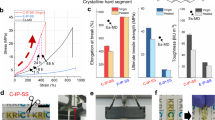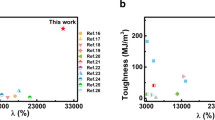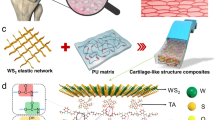Abstract
It is a challenge to synthesize materials that possess the properties of biological muscles—strong, elastic and capable of self-healing. Herein we report a network of poly(dimethylsiloxane) polymer chains crosslinked by coordination complexes that combines high stretchability, high dielectric strength, autonomous self-healing and mechanical actuation. The healing process can take place at a temperature as low as −20 °C and is not significantly affected by surface ageing and moisture. The crosslinking complexes used consist of 2,6-pyridinedicarboxamide ligands that coordinate to Fe(III) centres through three different interactions: a strong pyridyl–iron one, and two weaker carboxamido–iron ones through both the nitrogen and oxygen atoms of the carboxamide groups. As a result, the iron–ligand bonds can readily break and re-form while the iron centres still remain attached to the ligands through the stronger interaction with the pyridyl ring, which enables reversible unfolding and refolding of the chains. We hypothesize that this behaviour supports the high stretchability and self-healing capability of the material.
This is a preview of subscription content, access via your institution
Access options
Subscribe to this journal
Receive 12 print issues and online access
$259.00 per year
only $21.58 per issue
Buy this article
- Purchase on Springer Link
- Instant access to full article PDF
Prices may be subject to local taxes which are calculated during checkout




Similar content being viewed by others
References
Wu, D. Y., Meure, S. & Solomon, D. Self-healing polymeric materials: a review of recent developments. Prog. Polym. Sci. 33, 479–522 (2008).
Yang, Y. & Urban, M. W. Self-healing polymeric materials. Chem. Soc. Rev. 42, 7446–7467 (2013).
Binder, W. H. Self-Healing Polymers: From Principles to Applications (Wiley-VCH, 2013).
Burnworth, M. et al. Optically healable supramolecular polymers. Nature 472, 334–337 (2011).
Ghosh, B. & Urban, M. W. Self-repairing oxetane-substituted chitosan polyurethane networks. Science 323, 1458–1460 (2009).
Chen, X. et al. A thermally re-mendable cross-linked polymeric material. Science 295, 1698–1702 (2002).
Toohey, K. S., Sottos, N. R., Lewis, J. A., Moore, J. S. & White, S. R. Self-healing materials with microvascular networks. Nature Mater. 6, 581–585 (2007).
Caruso, M. M. et al. Solvent-promoted self-healing epoxy materials. Macromolecules 40, 8830–8832 (2007).
Jackson, A. C., Bartelt, J. A. & Braun, P. V. Transparent self-healing polymers based on encapsulated plasticizers in a thermoplastic matrix. Adv. Funct. Mater. 21, 4705–4711 (2011).
White, S. R. et al. Autonomic healing of polymer composites. Nature 409, 794–797 (2001).
Wang, Q. et al. High-water-content mouldable hydrogels by mixing clay and a dendritic molecular binder. Nature 463, 339–343 (2010).
Cordier, P., Tournilhac, F., Soulie-Ziakovic, C. & Leibler, L. Self-healing and thermoreversible rubber from supramolecular assembly. Nature 451, 977–980 (2008).
Tee, B. C.-K., Wang, C., Allen, R. & Bao, Z. An electrically and mechanically self-healing composite with pressure- and flexion-sensitive properties for electronic skin applications. Nature Nanotech. 7, 825–832 (2012).
Chen, Y., Kushner, A. M., Williams, G. A. & Guan, Z. Multiphase design of autonomic self-healing thermoplastic elastomers. Nature Chem. 4, 467–472 (2012).
Wang, C. et al. A rapid and efficient self-healing thermo-reversible elastomer crosslinked with graphene oxide. Adv. Mater. 25, 5785–5790 (2013).
Balkenende, D. W. R. et al. Mechanochemistry with metallosupramolecular polymers. J. Am. Chem. Soc. 136, 10493–10498 (2014).
Bode, S. et al. Self-healing polymer coatings based on crosslinked metallosupramolecular copolymers. Adv. Mater. 25, 1634–1638 (2013).
Bode, S. et al. Self-healing metallopolymers based on cadmium bis(terpyridine) complex containing polymer networks. Polym. Chem. 4, 4966–4973 (2013).
Sandmann, B. et al. The self-healing potential of triazole–pyridine-based metallopolymers. Macromol. Rapid Commun. 36, 604–609 (2015).
Yang, B. et al. Self-healing metallo-supramolecular polymers from a ligand macromolecule synthesized via copper-catalyzed azide–alkyne cycloaddition and thiol–ene double ‘click’ reactions. Polym. Chem. 5, 1945–1953 (2014).
Krogsgaard, M., Behrens, M. A., Pedersen, J. S. & Birkedal, H. Self-healing mussel-inspired multi-pH-responsive hydrogels. Biomacromolecules 14, 297–301 (2013).
Basak, S., Nanda, J. & Banerjee, A. Multi-stimuli responsive self-healing metallo-hydrogels: tuning of the gel recovery property. Chem. Commun. 50, 2356–2359 (2014).
Zheng, P., Wang, Y. & Li, H. Reversible unfolding–refolding of rubredoxin: a single-molecule force spectroscopy study. Angew. Chem. Int. Ed. 53, 14060–14063 (2014).
Zheng, P., Arantes, G. M., Field, M. J. & Li, H. Force-induced chemical reactions on the metal centre in a single metalloprotein molecule. Nature Commun. 6, 7569 (2015).
Sollich, P. Rheological constitutive equation for a model of soft glassy materials. Phys. Rev. E 58, 738–759 (1998).
Sun, J. Y. et al. Highly stretchable and tough hydrogels. Nature 489, 133–136 (2012).
Sun, T. L. et al. Physical hydrogels composed of polyampholytes demonstrate high toughness and viscoelasticity. Nature Mater. 12, 932–937 (2013).
Bhowmick, A. K., & Stephens, H. Handbook of Elastomers (CRC Press, 2000).
Iyer, B. V. S. et al. Modeling the response of dual cross-linked nanoparticle networks to mechanical deformation. Soft Matter 9, 109–121 (2013).
Iyer, B. V. S. et al. Strain recovery and self-healing in dual cross-linked nanoparticle networks. Polymer Chem. 4, 4927–4939 (2013).
Iyer, B. V. et al. Ductility, toughness and strain recovery in self-healing dual cross-linked nanoparticle networks studied by computer simulations. Prog. Polymer Sci. 40, 121–137 (2015).
Gossweiler, G. R. et al. Mechanochemical activation of covalent bonds in polymers with full and repeatable macroscopic shape recovery. ACS Macro Lett. 3, 216–219 (2014).
Holten-Anderson, N. et al. pH-induced metal–ligand crosslinks inspired by mussel yield self-healing polymer networks with near covalent elastic moduli. Proc. Natl Acad. Sci. USA 108, 2651 (2011).
Grindy, S. C. et al. Control of hierarchical polymer mechanics with bioinspired metal-coordination dynamics. Nature Mater. 14, 1210–1216 (2015).
Kushner, A. M., Gabuchian, V., Johnson, E. G. & Guan, Z. Biomimetic design of reversibly unfolding cross-linker to enhance mechanical properties of 3D network polymers. J. Am. Chem. Soc. 129, 14110–14111 (2007).
Burattini, S. et al. A healable supramolecular polymer blend based on aromatic π–π stacking and hydrogen-bonding interactions. J. Am. Chem. Soc. 132, 12051–12058 (2010).
Kakuta, T. et al. Preorganized hydrogel: self-healing properties of supramolecular hydrogels formed by polymerization of host–guest-monomers that contain cyclodextrins and hydrophobic guest groups. Adv. Mater. 25, 2849–2853 (2013).
Mozhdehi, D., Ayala, S., Cromwell, O. R. & Guan, Z. Self-healing multiphase polymers via dynamic metal–ligand interactions. J. Am. Chem. Soc. 136, 16128–16131 (2014).
Pelrine, R., Kornbluh, R., Pei, Q. & Joseph, J. High-speed electrically actuated elastomers with strain greater than 100%. Science 287, 836–839 (2000).
Anderson, I. A., Gisby, T. A., McKay, T. G., O'Brien, B. M. & Calius, E. P. Multi-functional dielectric elastomer artificial muscles for soft and smart machines. J. Appl. Phys. 112, 041101 (2012).
Keplinger, C. et al. Stretchable, transparent, ionic conductors. Science 341, 984–987 (2013).
Xie, T. Tunable polymer multi-shape memory effect. Nature 464, 267–270 (2010).
Keplinger, C., Li, T., Baumgartner, R., Suo, Z. & Bauer, S. Harnessing snap-through instability in soft dielectrics to achieve giant voltage-triggered deformation. Soft Matter 8, 285–288 (2012).
Hunt, S., McKay, T. G. & Anderson, I. A. A self-healing dielectric elastomer actuator. Appl. Phys. Lett. 104, 113701 (2014).
Yuan, W. et al. Fault-tolerant dielectric elastomer actuators using single-walled carbon nanotube electrodes. Adv. Mater. 20, 621–625 (2008).
Acknowledgements
This work was partially supported by the Major State Basic Research Development Program (Grant No. 2013CB922100 and Grant No. 2011CB808704), Air Force Office of Scientific Research (FA9550-15-1-0106) and Samsung Electronics. F.L. thanks the Swiss National Science Foundation for an Early Mobility Postdoc grant. We thank J. Ma for helpful discussions on the DFT calculations and X. R. Lu, J. C. Lai, X. Y. Jia and J. F. Mei for assistance in the synthesis and characterization of the model complex.
Author information
Authors and Affiliations
Contributions
C.-H.L., C.W. and Z.B. conceived, designed and directed the project; C.-H.L., C.W., C.K., Y.S., P.Z., Y.C. and F.L. performed the experiments; C.-H.L., C.W., C.K., Y.S., P.Z., Y.C., F.L., J.-L.Z, X.-Z.Y., L.J., C.L. and Z.B. analysed the data; C.-H.L., C.W. and Z.B. wrote the paper. All the authors discussed the results and commented on the manuscript.
Corresponding author
Ethics declarations
Competing interests
Stanford University has filed a provisional application for a patent based on this technology that names C.H.L., C.W. and Z.B. as inventors.
Supplementary information
Supplementary information
Supplementary information (PDF 1858 kb)
Supplementary information
Supplementary Movie 1 (WMV 3255 kb)
Supplementary information
Supplementary Movie 2 (WMV 2332 kb)
Rights and permissions
About this article
Cite this article
Li, CH., Wang, C., Keplinger, C. et al. A highly stretchable autonomous self-healing elastomer. Nature Chem 8, 618–624 (2016). https://doi.org/10.1038/nchem.2492
Received:
Accepted:
Published:
Issue Date:
DOI: https://doi.org/10.1038/nchem.2492
This article is cited by
-
A Self-Healing Optoacoustic Patch with High Damage Threshold and Conversion Efficiency for Biomedical Applications
Nano-Micro Letters (2024)
-
Toughening self-healing elastomer crosslinked by metal–ligand coordination through mixed counter anion dynamics
Nature Communications (2023)
-
Conformation-Induced stiffening effect of crosslinked polymer thin films
Communications Physics (2023)
-
Full-color persistent room temperature phosphorescent elastomers with robust optical properties
Nature Communications (2023)
-
Floatable photocatalytic hydrogel nanocomposites for large-scale solar hydrogen production
Nature Nanotechnology (2023)



